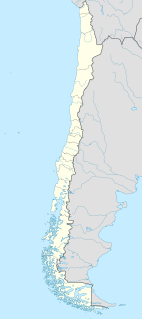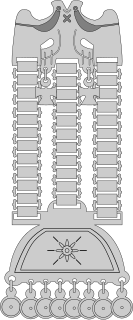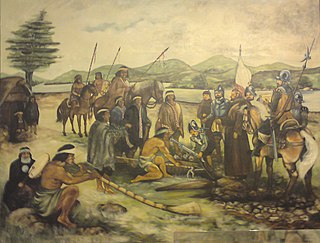
The 1793 Parliament of Negrete was a diplomatic meeting between Mapuches and Spanish authorities held in Negrete. The parliament was held from March 4 to March 6 of 1793. 161 caciques and 2380 Mapuche warriors attended the meeting. [1]

The 1793 Parliament of Negrete was a diplomatic meeting between Mapuches and Spanish authorities held in Negrete. The parliament was held from March 4 to March 6 of 1793. 161 caciques and 2380 Mapuche warriors attended the meeting. [1]

The Huilliche[wi.ˈʝi.tʃe], Huiliche or Huilliche-Mapuche are the southern partiality of the Mapuche macroethnic group of Chile. The Huilliche are the principal indigenous population of Chile from Toltén River to Chiloé Archipelago. According to Ricardo E. Latcham the term Huilliche started to be used in Spanish after the second founding of Valdivia in 1645, adopting the usage of the Mapuches of Araucanía for the southern Mapuche tribes. Huilliche means 'southerners'

The Mapuche are a group of indigenous inhabitants of present-day south-central Chile and southwestern Argentina, including parts of present-day Patagonia. The collective term refers to a wide-ranging ethnicity composed of various groups who shared a common social, religious, and economic structure, as well as a common linguistic heritage as Mapudungun speakers. Their influence once extended from Aconcagua Valley to Chiloé Archipelago and spread later eastward to Puelmapu a land compromising part of the Argentine pampa and Patagonia. Today the collective group makes up over 80% of the indigenous peoples in Chile, and about 9% of the total Chilean population. The Mapuche are particularly concentrated in the Araucanía region. Many have migrated from rural areas to the cities of Santiago and Buenos Aires for economic opportunities.

The Arauco War was a long-running conflict between colonial Spaniards and the Mapuche people, mostly fought in the Araucanía. The conflict begun at first as a reaction to the Spanish conquest attempt establishing cities and forcing Mapuches into servitude. It subsequently evolved over time into phases, drawn-out sieges, slave-hunting expeditions, pillaging raids, punitive expeditions, and renewed Spanish attempts to secure lost territories. Abduction of women and war rape was common on both sides.

Angol is a commune and capital city of the Malleco Province in the Araucanía Region of southern Chile. It is located at the foot of the Nahuelbuta Range and next to the Vergara River, that permitted communications by small boats to the Bío-Bío River and Concepción. This strategic position explains the successive foundations of this city during the Arauco War. It was first founded in 1553 as a "conquistador" fort of Confines, the fort was later destroyed and rebuilt several times and it was not until the Pacification of Araucania in the late 19th century that it was rebuilt with the name of Angol. The city has a current population of approximately 49,000. Within the electoral divisions of Chile, it belongs to the 48th electoral district and the 14th senatorial circumscription.

The Occupation of Araucanía or Pacification of Araucanía (1861–1883) was a series of military campaigns, agreements and penetrations by the Chilean army and settlers into Mapuche territory which led to the incorporation of Araucanía into Chilean national territory. Pacification of Araucanía was the expression used by the Chilean authorities for this process. The conflict was concurrent with Argentine campaigns against the Mapuche (1878–1885) and Chile's wars with Spain (1865–1866) and with Peru and Bolivia (1879–1883).
La Frontera is the name given to a geographical region in Chile. La Frontera can denote either the area just around Bío Bío River or the whole area between the Bío Bío and Toltén River being in this later definition largely coterminous with the historical usage of Araucanía.

Tucapel is a town and commune in the Arauco Province, Bío Bío Region, Chile. It was once a region of Araucanía named for the Tucapel River. The name of the region derived from the rehue and aillarehue of the Moluche people of the area between the Lebu and the Lleulleu Rivers, who were famed for their long resistance to the Spanish in the Arauco War. Tucapel is also the name of a famous leader from that region in the first resistance against the Spanish mentioned in Alonso de Ercilla's epic poem La Araucana. Formerly belonging to the Nuble Province, in the Department of Yungay. Near the town of Tucapel is the Plaza de San Diego de Tucapel. The capital of the commune is the town of Huépil, moving the municipality from Tucapel in 1967. In mapudungún its name means "To seize or to take by force".
Vilumilla was the Mapuche Toqui elected in 1722 to lead the Mapuche Uprising of 1723 against the Spanish for their violation of the peace.

San Rosendo is a Chilean city and commune in Bío Bío Province, Bío Bío Region.

Negrete is a Chilean town and commune in Bío Bío Province, Bío Bío Region. It is bordered by the commune of Los Ángeles to the north, Renaico to the south, Mulchén to the east and Nacimiento to the west.
The Parliament of Malloco was held between governor Juan Henríquez de Villalobos and leaders of the Mapuche in January 1671, at Malloco southwest of Santiago, Chile.
The 1726 Parliament of Negrete was a diplomatic meeting between Mapuches and Spanish authorities held in Negrete. During the parliament a peace treaty was signed, bringing an end to a period of warfare that begun in with the Mapuche uprising of 1723.

Mapuche silverwork is one of the best known aspects of Mapuche material culture. The adornments have been subject to changes in fashion but some designs have resisted change.
Mañil or Magnil was a Mapuche lonko who fought in the 1851 Chilean Revolution and led an uprising in 1859. He was the main chief of the Arribanos and the father of Quilapán who led Mapuche forces in the Occupation of Araucanía.
The Parliament of Coz Coz was a meeting between Mapuches chiefs held on January 18, 1907 to discuss land conflicts with non-Mapuche Chileans. The parliament was organized with the help of Capuchins who invited journalists from Valdivia and Santiago to the meeting. The parliament was held in the vicinity of Panguipulli.
The Mapuche people of southern Chile and Argentina have a long history dating back as an archaeological culture to 600–500 BC. The Mapuche society had great transformations after Spanish contact in the mid–16th century. These changes included the adoption of Old World crops and animals and the onset of a rich Spanish–Mapuche trade in La Frontera and Valdivia. Despite these contacts Mapuche were never completely subjugated by the Spanish Empire. Between the 18th and 19th century Mapuche culture and people spread eastwards into the Pampas and the Patagonian plains. This vast new territory allowed Mapuche groups to control a substantial part of the salt and cattle trade in the Southern Cone.

The Parliament of Las Canoas was a diplomatic meeting between Mapuche-Huilliches and Spanish authorities in 1793 held at the confluence of Rahue River and Damas River near what is today the city of Osorno. The parliament was summoned by the Royal Governor of Chile Ambrosio O'Higgins after the Spanish had suppressed an uprising by the Mapuche-Huilliches of Ranco and Río Bueno in 1792. The parliament is historically relevant since the treaty signed at the end of the meeting allowed the Spanish to reestablish the city of Osorno and secure the transit rights between Valdivia and the Spanish mainland settlements near Chiloé Archipelago. The indigenous signatories recognized the king of Spain as their sovereign but they kept considerable autonomy in the lands they did not ceded. The treaty is unique in that it was the first time Mapuches formally ceded territory to the Spanish.
The Parliament of Quillín was a diplomatic meeting held in 1641 between various Mapuche groups and Spanish authorities held in the fields of Quillín. With the ensuing treaty the Spanish sought an end to the hostilities of the Arauco War in order to concentrate the empire's resources in fighting the Catalans in Europe. This way the Mapuche obtained a peace treaty and a recognition on behalf of the crown in a case unique for any indigenous group in the Americas. Another contributing factor for parties to wanting to end warfare may have been the 1640 eruption of Llaima volcano in the middle of the conflict zone. Possibly Mapuches interpreted the eruption as a signal sent from the pillanes.
The Mapuche uprising of 1723 begun with the killing of Pascual Delgado by Mapuches and continued until Mapuche factions begun to sue for peace in 1725. The Spanish reinforced the fort of Purén, and most of the Spanish managed to find refuge in the various forts without being intercepted or harassed by Mapuches. On August Mapuche toki Vilumilla pushed north occupying Isla del Laja, that is the lands between Bío Bío and Laja rivers. The Spanish led by Manuel de Salamanca attacked a Mapuche encampment of warriors August 24, a day of heavy rain. The Mapuche initially fought with tenacity but came to believe they were being surrounded so they fled the scene.
The Huilliche uprising of 1792 was an indigenous uprising against the Spanish penetration into Futahuillimapu, territory in southern Chile that had been de facto free of Spanish rule since 1602. The first part of the conflict was a series of Huilliche attacks on Spanish settlers and the mission in the frontier next to Bueno River. Following this a militia in charge of Tomás de Figueroa departed from Valdivia ravaging Huilliche territory in a quest to punish those involved in the attacks.
|journal= (help)